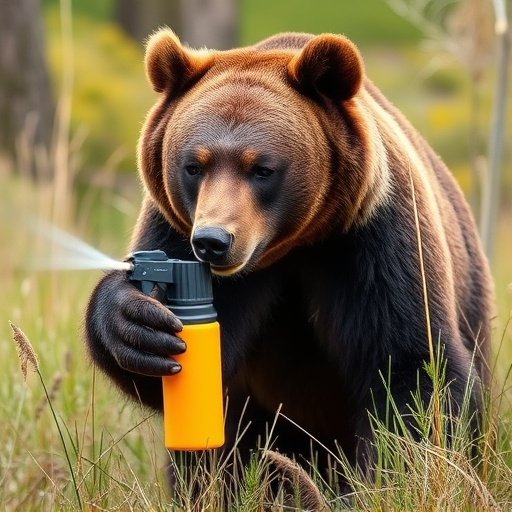Bear spray, with capsicum as its active ingredient, is an effective deterrent for bear encounters in infested areas, working best within a 20-30 foot (6-9 meter) range. This optimal distance ensures direct application to bears' sensitive faces, but it's influenced by user skill, wind conditions, spray type, terrain, and environmental factors. Proper training, quick deployment, and adherence to regulations maximize its effectiveness, making bear spray a valuable tool for outdoor safety, although no method guarantees complete protection.
“Discover the power of bear spray as a crucial tool for personal safety in wild environments. This comprehensive guide explores the science behind its effectiveness, delving into the active ingredients and how they work. We uncover the factors that influence the optimal range for maximum impact, providing insights on usage techniques to ensure its efficacy.
From real-world studies to survival stories, this article highlights the success of bear spray as a deterrent, offering practical advice on the best distance to maintain for its effectiveness.”
- Understanding Bear Spray: How It Works and Its Active Ingredients
- Factors Affecting the Effective Range of Bear Spray
- Best Practices for Using Bear Spray: Maximizing Its Efficacy
- Real-World Studies and Success Stories: Demonstrating Bear Spray's Effectiveness
Understanding Bear Spray: How It Works and Its Active Ingredients
Bear spray, also known as bear repellent, is a powerful tool designed to deter aggressive bears and provide a safe escape during encounters in wild environments. Understanding how it works and its active ingredients is crucial when considering its effectiveness as a deterrent. This defense mechanism uses capsicum, a compound found in chili peppers, as its primary active ingredient. When sprayed, the capsaicin irritates the bear’s eyes, nose, and respiratory tract, causing them to flee from the area.
The best distance for bear spray effectiveness is typically within 20-30 feet (6-9 meters), though this can vary depending on factors like wind and the size of the bear. At this range, the spray creates a barrier that can deter bears and give users precious time to retreat or seek shelter. Regular practice of spraying techniques and ensuring the spray is up-to-date and properly stored are essential for maximizing its potential as a safety measure in bear country.
Factors Affecting the Effective Range of Bear Spray
The effectiveness of bear spray is influenced by several key factors, which can impact the best distance for its use as a deterrent. The primary considerations are the sprayer’s skill and consistency in application, as well as environmental conditions. Wind direction and speed play a significant role, with tailwinds carrying the spray further and headwinds reducing its range. Additionally, the type of bear spray used matters; different formulations have varying concentrations and can affect the reach and potency of the spray.
Terrain also comes into play, as rough or uneven ground can disrupt the spray pattern and reduce its overall effectiveness. Distance is another critical aspect; while bear spray can deter bears from close range, its efficacy decreases significantly beyond 30 feet (approximately 9 meters). The best distance for maximum effectiveness lies between 20 to 30 feet, ensuring a strong enough spray cloud to disrupt the bear’s behavior without posing an unnecessary risk to the user.
Best Practices for Using Bear Spray: Maximizing Its Efficacy
When it comes to using bear spray, understanding the best practices is key to maximizing its effectiveness as a deterrent. The optimal distance for bear spray to be successful is around 20 to 30 feet (6 to 9 meters). This range ensures that you’re close enough to apply the spray directly onto the bear’s face, which is the most sensitive area. However, it’s crucial not to get too close, as bears may still charge despite the spray.
To make sure your bear spray works best, follow these tips: always carry it in an easily accessible location, familiarize yourself with its operation before heading into bear country, and be prepared to deploy it quickly and accurately when needed. Additionally, ensure that you’re aware of local regulations regarding bear spray use and storage, as proper handling is essential for safety and legal compliance.
Real-World Studies and Success Stories: Demonstrating Bear Spray's Effectiveness
Real-world studies and success stories paint a clear picture of bear spray’s effectiveness as a deterrent. Research shows that when used properly, bear spray can be highly successful in deterring bears from approaching humans. The best distance for bear spray effectiveness is typically considered to be within 20 to 30 feet (6 to 9 meters), although this range can vary depending on several factors such as wind conditions, the size and agitation level of the bear, and the specific type of bear spray used.
Numerous stories from hikers, campers, and park rangers attest to the power of bear spray in avoiding dangerous encounters. These accounts often highlight how a quick application of bear spray can cause bears to retreat, allowing individuals to safely escape or find shelter. While no deterrent is 100% guaranteed, especially in extreme cases where bears are starving or protective of cubs, bear spray remains a valuable tool for minimizing the risk of attacks and promoting safe outdoor experiences.
Bear spray has proven to be an effective deterrent, with a best distance for effectiveness ranging from 20 to 30 feet. However, its success depends on various factors such as wind direction and weather conditions. By understanding how bear spray works and following best practices, individuals can maximize its efficacy in real-world scenarios. Studies and success stories highlight its ability to prevent aggressive encounters, making it a valuable tool for outdoor enthusiasts navigating bear country.
